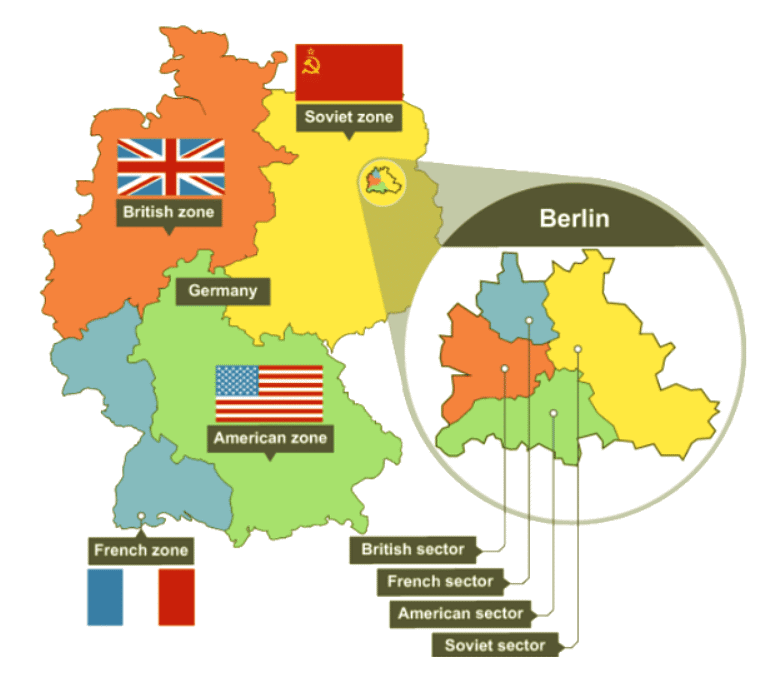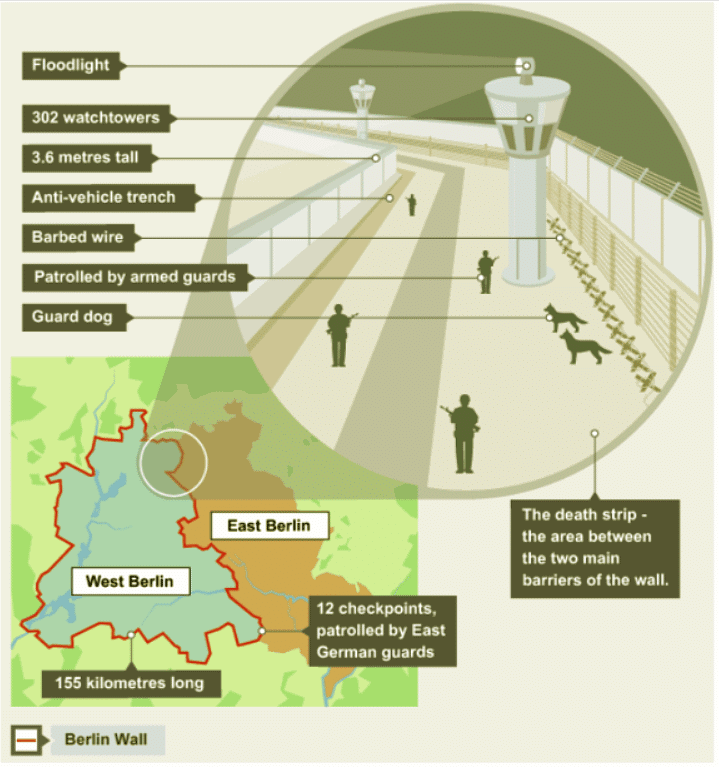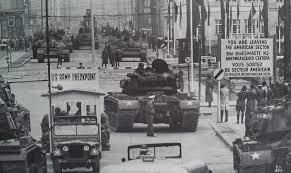Year 7 Exam > Year 7 Notes > The Berlin Wall
The Berlin Wall - Year 7 PDF Download
| Table of contents |

|
| Introduction |

|
| Berlin in 1961 |

|
| The Vienna Summit, 1961 |

|
| Building the Berlin Wall |

|
| Life with the Berlin Wall |

|
| Escaping East Berlin |

|
| Checkpoint Charlie |

|
| The fall of the Berlin Wall |

|
Introduction
- At the Yalta Conference in 1945, post-World War II, it was agreed upon that Germany would be divided into four zones, each controlled by the Soviet Union, UK, America, and France. Berlin, situated in the Soviet zone, was also to be divided into four sectors.
- In August 1961, the Soviet Union initiated the construction of a wall around West Berlin, governed by the USA, UK, and France. This barrier, known as the Berlin Wall, stood until 1989, symbolizing the Cold War's ideological divide between East and West.
Berlin in 1961
- By 1961, Berlin was divided into East Berlin and West Berlin, with the former falling under Soviet control in East Germany. The initial understanding, agreed upon at the Yalta Conference in 1945, envisioned a temporary division of Germany until free and fair elections could be organized. However, by 1961, the prospect of such elections seemed increasingly remote.
- West Germany, under the control of the United Kingdom, the United States, and France, experienced remarkable economic growth, attracting over 3 million East German citizens seeking better prospects between 1945 and 1961. Prior to the construction of the Berlin Wall, movement between the Soviet sector and the Western zones was relatively unrestricted, with a simple sign demarcating the crossing point.
- The exodus of skilled professionals and educated workers to West Germany severely strained the East German economy, exacerbating the challenges faced by the communist regime. This mass migration was perceived as a significant propaganda setback for East Germany and its adherence to communism.
- At the Vienna Summit in June 1961, Soviet leader Nikita Khrushchev demanded that the United States relinquish control of West Berlin, allowing it to become part of East Germany under Soviet influence. However, American President John F. Kennedy refused to concede to this demand, citing its implications for the strategic interests of the United States and its allies.
The Vienna Summit, 1961
- At the Vienna Summit in June 1961, Soviet leader Nikita Khrushchev demanded that the US relinquish control of West Berlin, proposing its integration into East Germany under Soviet control. However, American President John F. Kennedy rejected this demand.
 The four zones of Germany and Berlin
The four zones of Germany and Berlin
Building the Berlin Wall
- On August 13, 1961, a barbed wire fence was hastily erected along the border between East and West Berlin. The Soviet authorities justified this action by claiming it was necessary to prevent espionage activities, accusing Western agents of infiltrating the East for intelligence gathering purposes.
- However, this initial barrier was soon replaced by a formidable concrete wall that encircled West Berlin, heavily guarded by armed personnel. Citizens of East Berlin were warned that any attempt to flee to the West would be considered an act of dissent, punishable by death.

Question for The Berlin WallTry yourself: What was the main reason for the construction of the Berlin Wall?View Solution
Life with the Berlin Wall
- The sudden construction of the Berlin Wall resulted in the abrupt separation of families and loved ones, with people from East Berlin prohibited from crossing into West Berlin. The wall was heavily guarded by armed personnel under orders to shoot anyone attempting to escape.
- Despite the physical and psychological barriers imposed by the wall, West Berlin experienced economic prosperity, largely due to investments from the United States. Military forces from the US, UK, and France remained stationed in the West, and road access to West Germany provided a degree of freedom for its citizens.
- In contrast, East Berlin struggled economically, with shortages of consumer goods and long waiting lists for basic necessities such as cars, which could take up to ten years to obtain. This environment fostered a sense of claustrophobia and discontent among East Berlin citizens, a phenomenon known as "Wall sickness."
- Nevertheless, the communist government attempted to showcase the superiority of their system by undertaking projects such as the construction of the towering TV Tower near the border with the West. Standing at 368 meters tall, it was both a symbol of Communist power and a landmark for Berlin, albeit one overshadowed by the oppressive presence of the Berlin Wall.
Escaping East Berlin
- During the years spanning from 1961 to 1989, numerous individuals in East Berlin harbored dreams of a better life in the West. Many successfully fled to the more prosperous Western regions, yet tragically, at least 140 lives were lost in attempted crossings.
Checkpoint Charlie
- Checkpoint Charlie served as a pivotal crossing point between East and West Berlin, where foreigners and diplomats regularly traversed between the sectors. An incident on October 22, 1961, involved an American diplomat and his wife being denied entry into East Berlin due to their refusal to present required documentation.
- Retaliation by General Clay, the head of American forces in Berlin, ensued as tanks were dispatched to the checkpoint. This standoff quickly escalated, positioning US and Soviet tanks merely 75 meters apart, on the brink of potential conflict. Fortunately, a full-scale war was averted when both sides de-escalated the situation six days later, withdrawing their tanks. This diplomatic resolution preserved the control of West Berlin under the Western allies.
 US and Soviet tanks face one another at Checkpoint Charlie, just 75 metres apart
US and Soviet tanks face one another at Checkpoint Charlie, just 75 metres apart
John F Kennedy's visit
- In June 1963, US President John F. Kennedy made a significant visit to West Berlin.
- Kennedy delivered a memorable speech in front of over 100,000 West Berliners at the Berlin Wall.
- He famously declared 'Ich bin ein Berliner,' symbolizing America's solidarity with the people of West Berlin.
The fall of the Berlin Wall
- By 1989, cracks were beginning to appear in the Eastern bloc. Protests erupted in Polish shipyards, and the Soviet Union was embroiled in a challenging conflict in Afghanistan. Mikhail Gorbachev, the leader of the Soviet Union, championed policies of openness and reform.
- On 9 November 1989, in a momentous turn of events, East German border guards opened checkpoints, allowing unrestricted movement across the border into West Berlin. Thousands of people flocked to the once-restricted area, initiating the spontaneous dismantling of the Berlin Wall. The dismantling process was formally initiated by the East German Border Troops on 13 June 1990.
- The fall of the Berlin Wall symbolized a significant shift in Soviet attitudes toward Berlin. It marked an acknowledgment that West Berlin would remain a capitalist enclave. Moreover, the wall's existence served as a stark reminder of communism's need to erect physical barriers to maintain control over its population.
- Today, remnants of the Berlin Wall serve as poignant reminders of the city's divided past. Small segments of the wall remain in place, serving as historical artifacts, while a line of cobbles traces the former border where the wall once stood, serving as a solemn memorial to the era of division.
Question for The Berlin WallTry yourself: What was the purpose of the Berlin Wall?View Solution
FAQs on The Berlin Wall - Year 7
| 1. What was the main purpose of building the Berlin Wall in 1961? |  |
Ans. The main purpose of building the Berlin Wall in 1961 was to prevent East Berliners from escaping to West Berlin and to stop the flow of people defecting from East Germany to the West.
| 2. How did life change for residents of both East and West Berlin after the construction of the Berlin Wall? |  |
Ans. Life changed drastically for residents of both East and West Berlin after the construction of the Berlin Wall. Families were separated, and communication between the two sides became nearly impossible. East Berliners faced strict control and surveillance, while West Berliners experienced increased tension and fear of conflict.
| 3. What was the significance of Checkpoint Charlie during the time of the Berlin Wall? |  |
Ans. Checkpoint Charlie was one of the main crossing points between East and West Berlin during the time of the Berlin Wall. It was a symbol of the divided city and the Cold War, and it was where many dramatic events and exchanges took place, including the famous stand-off between American and Soviet tanks in 1961.
| 4. How did the fall of the Berlin Wall in 1989 impact the political landscape of Europe? |  |
Ans. The fall of the Berlin Wall in 1989 marked the end of the Cold War and the beginning of the reunification of Germany. It also led to significant changes in the political landscape of Europe, including the dissolution of the Soviet Union and the eventual expansion of the European Union.
| 5. What strategies did people use to escape from East Berlin during the time of the Berlin Wall? |  |
Ans. People used various strategies to escape from East Berlin during the time of the Berlin Wall, including digging tunnels, flying in hot air balloons, and even disguising themselves as Western tourists. These daring escape attempts often required careful planning and coordination to avoid detection by the authorities.
Related Searches













